Back in 2014, I prepared a post for Past is Present that featured four photographs of newspaper print shops, two from the collection and two recently acquired. In the three years since that post, AAS has added several more occupational images featuring print shops of all shapes and sizes. These images add to our knowledge of the appearance of nineteenth-century printing businesses, the people who worked there, and the machinery and spaces required for success. When looked at more broadly, the photographs also tell us something about the history of photography and its use to document work.
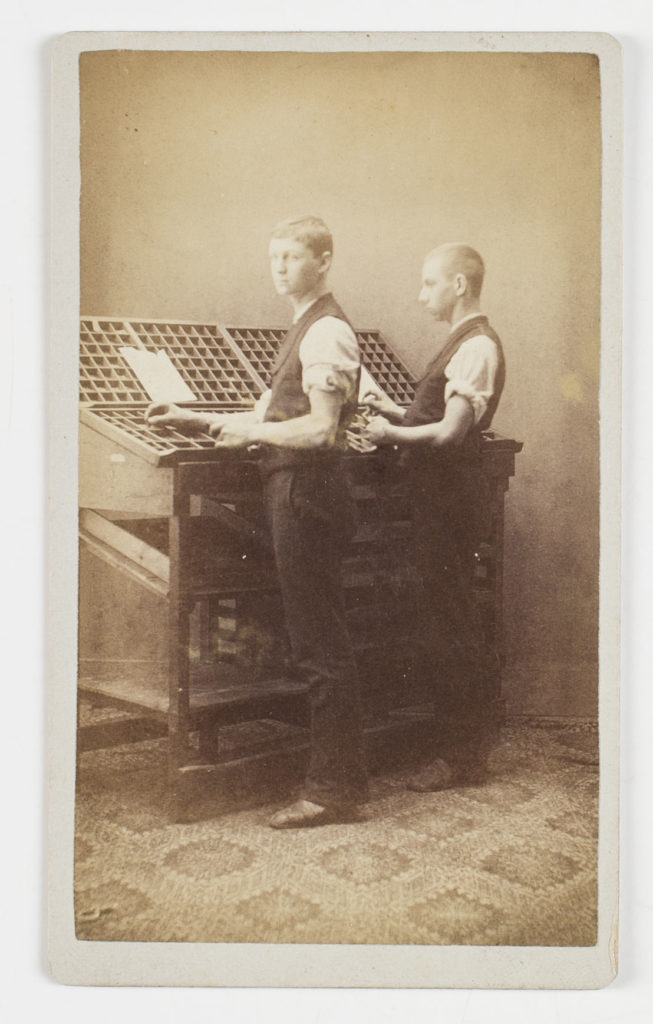 The carte-de-visite photograph format was invented in Europe around 1854 and was popular in the United States from that date to the late 1870s. Cartes-de-visites were usually albumen photographs mounted on 2 x 4” cards, making them perfect for slipping into albums, using as calling cards, or swapping with friends. We recently bought this circa 1875 carte-de-visite of unidentified typesetters standing in a studio with their type cases in a posed arrangement. The young men, shown in their shirt sleeves, would have carried the cases (which we suspect are empty of type for easy transport) to the photo studio to set up this shot. Occupational photographs like this are not unusual in America—sitters with shovels, machinery, tools, and other props are common enough—although this is the first we have seen with type cases! Mind your p’s and q’s, gentlemen, and be careful getting that rig back to the print shop!
The carte-de-visite photograph format was invented in Europe around 1854 and was popular in the United States from that date to the late 1870s. Cartes-de-visites were usually albumen photographs mounted on 2 x 4” cards, making them perfect for slipping into albums, using as calling cards, or swapping with friends. We recently bought this circa 1875 carte-de-visite of unidentified typesetters standing in a studio with their type cases in a posed arrangement. The young men, shown in their shirt sleeves, would have carried the cases (which we suspect are empty of type for easy transport) to the photo studio to set up this shot. Occupational photographs like this are not unusual in America—sitters with shovels, machinery, tools, and other props are common enough—although this is the first we have seen with type cases! Mind your p’s and q’s, gentlemen, and be careful getting that rig back to the print shop!
An image of the Boston Globe composing room, taken in 1887, turned up recently during a shift of the Society’s Boston photographs from one drawer to another. It was tucked inside a folder with unrelated material donated by AAS member Charles Henry Taylor Jr. (1867-1941, elected 1912), who worked for over forty years at the Globe as a journalist, editor, treasurer, and publisher. Here, the entire crew has stopped work to pose for the photographer who has brought his camera to the newspaper office to make the shot. This shows an important difference from the carte-de-visite image above, the success of which depended on the controlled environment of a photo studio. The decade between 1875 and 1885 saw many advancements in camera technologies and lens development which allowed cameras to finally move outside of the studio.
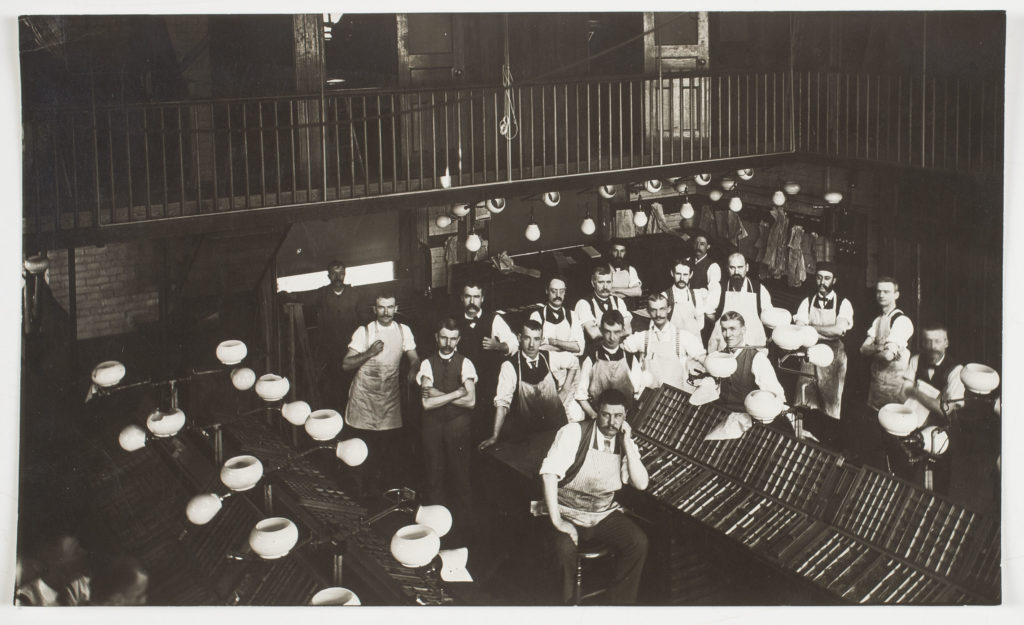
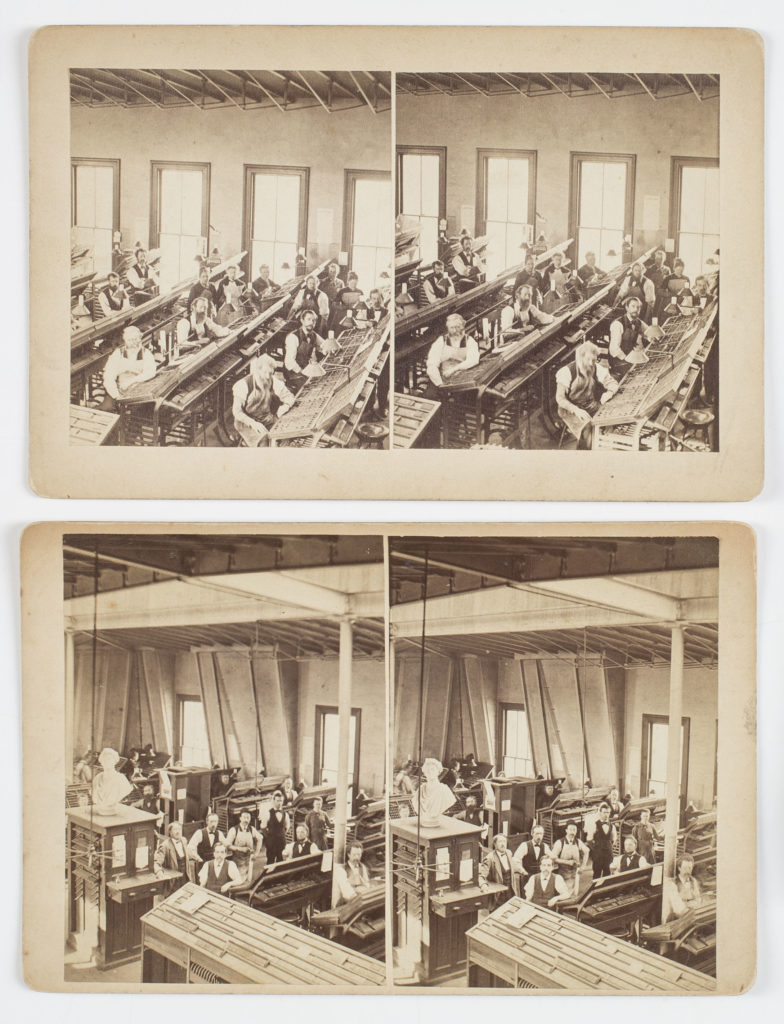 Taken around the same time as the Globe image, these two stereo views, taken about 1888, show the composing room of the Boston Transcript when it was located on Washington Street. The paper moved to that location after the 1872 Boston fire. The Transcript divided their composers into three teams, one for news, one for editorial, and a third for advertising. They also employed female composers and a few are visible in these group shots. Stereo photography became popular in the United States starting in the 1850s and the hand-held devices that allowed three-dimensional viewing continued to be used as entertainment in middle-class parlors well into the early twentieth century. Occupational images like this were often sold or given away by companies (like textile mills, manufacturers, and Sears & Roebuck) to promote their brand, to showcase new technologies, or to advertise their services.
Taken around the same time as the Globe image, these two stereo views, taken about 1888, show the composing room of the Boston Transcript when it was located on Washington Street. The paper moved to that location after the 1872 Boston fire. The Transcript divided their composers into three teams, one for news, one for editorial, and a third for advertising. They also employed female composers and a few are visible in these group shots. Stereo photography became popular in the United States starting in the 1850s and the hand-held devices that allowed three-dimensional viewing continued to be used as entertainment in middle-class parlors well into the early twentieth century. Occupational images like this were often sold or given away by companies (like textile mills, manufacturers, and Sears & Roebuck) to promote their brand, to showcase new technologies, or to advertise their services.
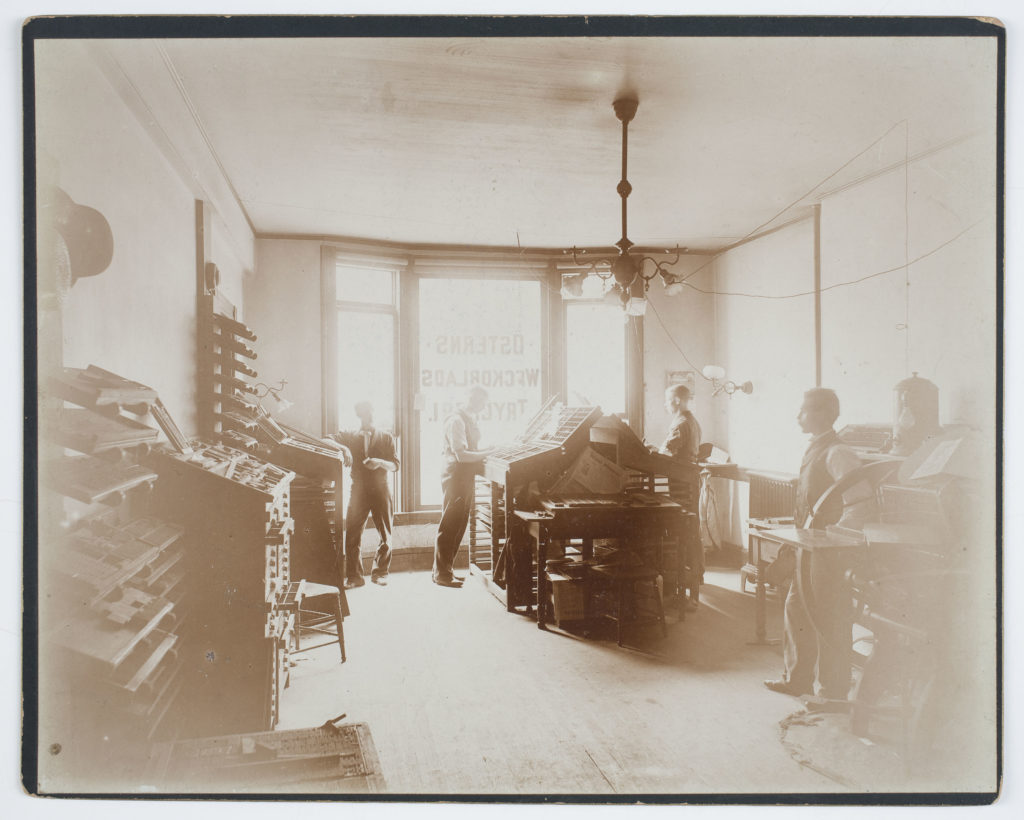 The Globe and the Transcript were big city papers with hundreds of employees. AAS is also very interested in smaller papers like the Österns Weckoblad (Eastern Weekly), whose Worcester, Massachusetts, office is shown in this circa 1896 photograph. Österns Weckoblad was a Swedish-language newspaper that was founded in New York in 1890, moved to Worcester in 1896, and then on to New Britain, Connecticut, before closing down in 1926. The type cases and composition area is at center and the wheel of a printing press can be seen at the far right. Sunlight pours in the large front window, which is emblazoned with the paper’s name. This photograph is larger than any of the others discussed so far, measuring 7 x 9”. It could have been made from a negative of that size, or it could have been printed using a solar enlarger. By the 1890s, enlargers were becoming more commonly available to photographers and were used to create large-format prints of factories, machinery, and shop fronts that were then prominently displayed in business offices or sent to prospective customers or investors.
The Globe and the Transcript were big city papers with hundreds of employees. AAS is also very interested in smaller papers like the Österns Weckoblad (Eastern Weekly), whose Worcester, Massachusetts, office is shown in this circa 1896 photograph. Österns Weckoblad was a Swedish-language newspaper that was founded in New York in 1890, moved to Worcester in 1896, and then on to New Britain, Connecticut, before closing down in 1926. The type cases and composition area is at center and the wheel of a printing press can be seen at the far right. Sunlight pours in the large front window, which is emblazoned with the paper’s name. This photograph is larger than any of the others discussed so far, measuring 7 x 9”. It could have been made from a negative of that size, or it could have been printed using a solar enlarger. By the 1890s, enlargers were becoming more commonly available to photographers and were used to create large-format prints of factories, machinery, and shop fronts that were then prominently displayed in business offices or sent to prospective customers or investors.
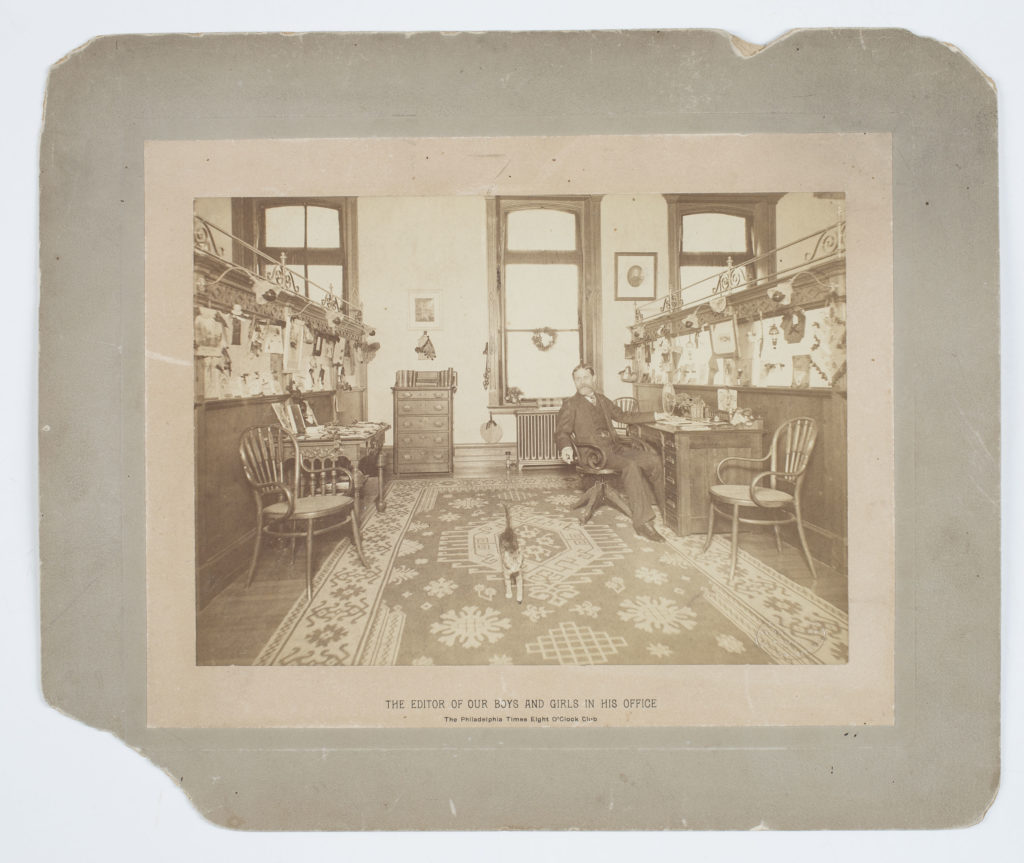 In March of 1893, D. B. Waggoner, the editor of the Eight O’clock Club column at the Philadelphia Times, had this photograph taken of himself in his office at the paper. The Eight O’clock Club was designed to engage young readers with the news and featured a variety of writing for children, from essays on natural phenomena to jokes, poetry, and fictional moral tales. Waggoner gestures to the club’s mascot, Semper the cat, who is ignoring him while trotting towards the photographer. The paper sent the photo out to club members—this one is inscribed by the editor to “Estelle, Hortense and Mary English” of Philadelphia. A label on the back explains that the image was “taken instantaneously by means of ‘flash light.’” Flash powder was used in fireworks and theatrical productions after the Civil War, but it was not until 1887 that two German inventors created BlitzLicht—a dangerous but effective blend of magnesium powder and potassium chlorate that could be ignited to create enough light to fill a room like Waggoner’s office and also allow the movement of Semper to be captured on film.
In March of 1893, D. B. Waggoner, the editor of the Eight O’clock Club column at the Philadelphia Times, had this photograph taken of himself in his office at the paper. The Eight O’clock Club was designed to engage young readers with the news and featured a variety of writing for children, from essays on natural phenomena to jokes, poetry, and fictional moral tales. Waggoner gestures to the club’s mascot, Semper the cat, who is ignoring him while trotting towards the photographer. The paper sent the photo out to club members—this one is inscribed by the editor to “Estelle, Hortense and Mary English” of Philadelphia. A label on the back explains that the image was “taken instantaneously by means of ‘flash light.’” Flash powder was used in fireworks and theatrical productions after the Civil War, but it was not until 1887 that two German inventors created BlitzLicht—a dangerous but effective blend of magnesium powder and potassium chlorate that could be ignited to create enough light to fill a room like Waggoner’s office and also allow the movement of Semper to be captured on film.
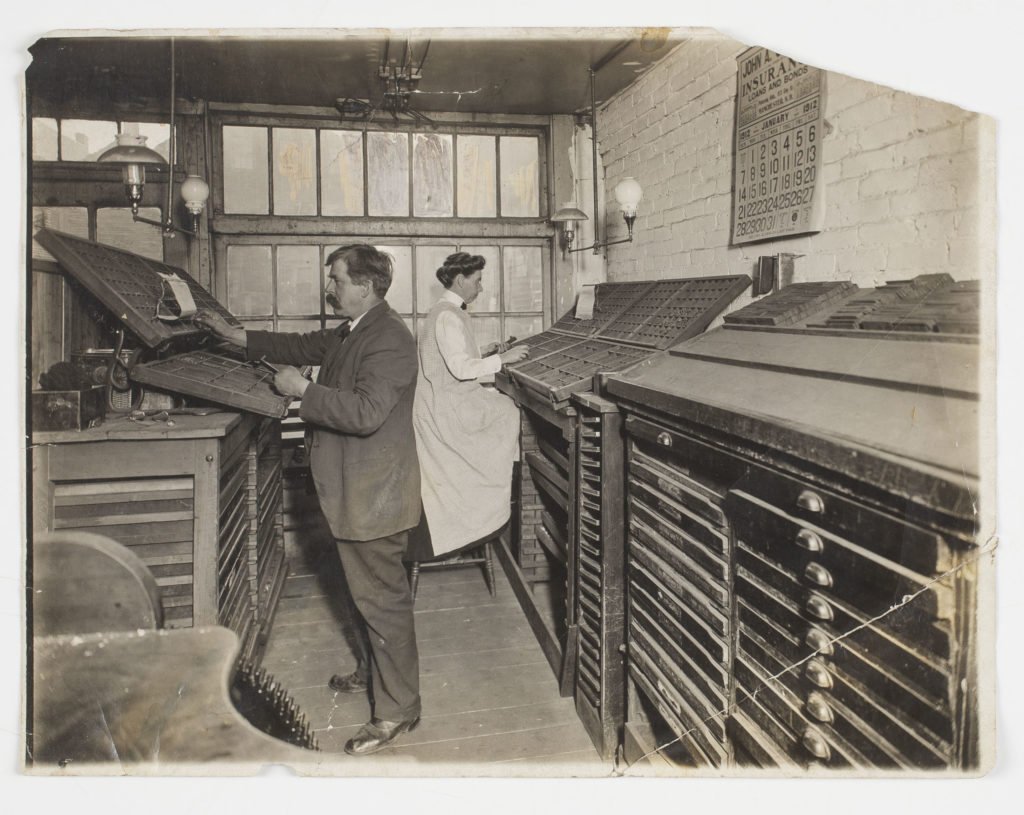 Finally, a 1912 photograph of staff at the Ruemely Press and Print Shop in Manchester, New Hampshire, is one of a set of six images that show a small print shop owned by Albert Ruemely. Founded around 1883, the shop did job work, specialized in Masonic printing, held contracts with the city clerk of Manchester, and offered German-language printing. In 1887, Ruemely added the printing of novelty advertising to his repertoire. This photograph is a silver gelatin print, rather than the albumen-based collodion wet plate technique used on many of the earlier images. Silver gelatin, which was a more stable photo printing process, was perfected around 1880 and became the dominant photographic printing process after 1900.
Finally, a 1912 photograph of staff at the Ruemely Press and Print Shop in Manchester, New Hampshire, is one of a set of six images that show a small print shop owned by Albert Ruemely. Founded around 1883, the shop did job work, specialized in Masonic printing, held contracts with the city clerk of Manchester, and offered German-language printing. In 1887, Ruemely added the printing of novelty advertising to his repertoire. This photograph is a silver gelatin print, rather than the albumen-based collodion wet plate technique used on many of the earlier images. Silver gelatin, which was a more stable photo printing process, was perfected around 1880 and became the dominant photographic printing process after 1900.
I continue to look for images of printers in America and hope to add photographs of shops large and small. They turn up on eBay, at paper fairs, in our own stacks, and from generous donors. My interest in these small reminders of past printers has rubbed off on the other curators here at AAS. Recently our curator of books picked up a small photographic print of a group of unknown printers, including four women, while hunting for books to add to the Society’s collection. From the washed out faces we can say flash powder was definitely used, so the photo is likely post-1890. We are still doing research on this image as it has only just arrived in Worcester. Maybe we’ll end up with enough images for another post in a year or two! 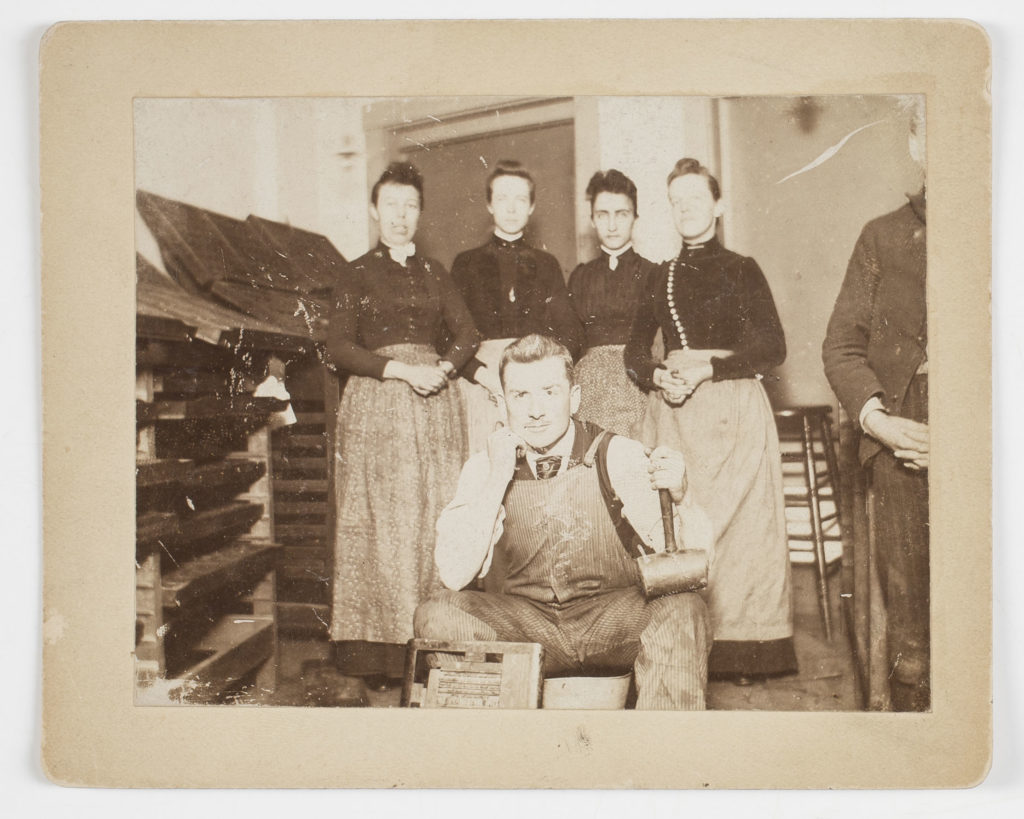

Cheese!
Peter, Do let us know if any photographs of print shops come your way! Lauren Hewes
As a lone offset female pressman locally and self-avowed press geek, I absolutely LOVE and admire the photos and history of my chosen profession!!! I have been printing for 20 years and have met only one other female in a print shop. Interestingly, we were BOTH lead operators of our daily and commercial shops. I am at my 2nd paper as lead pressman. Thank you so much for bringing history alive. I know I am living history now, although not recognized by most.